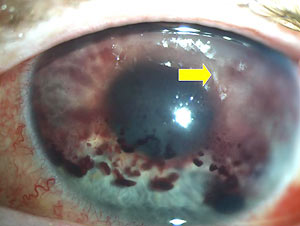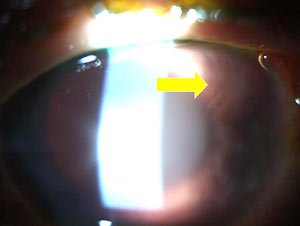Obstruction of Glaucoma Drainage Device with Fibrin Plug
Case Report
A 55-year-old man presented to the emergency department with a 2-day history of increasing left eye pain, nausea, and vomiting. He experienced a left-sided central retinal vein occlusion 10 weeks earlier and had been treated with panretinal photocoagulation. He was noted to have count fingers vision at 4 feet with an IOP of 62 mm Hg. The on-call physician diagnosed the patient with neovascular glaucoma and performed an intravitreal injection of bevacizumab (1.25 µg/0.05 mL) and initiated treatment with topical glaucoma drops and oral acetazolamide.
He was seen 2 days later by the glaucoma service and noted to have an IOP of 52 mm Hg on maximal medical therapy. Gonioscopy revealed a “zipped” angle with no view of the trabecular meshwork for 360 degrees. An Ahmed valve was implanted the following day with no intraoperative complications. On the first postoperative visit, the patient’s IOP was 51 mm Hg with significant blood in the anterior chamber (Slide 1) and fibrin occluding the tube. In an effort to reverse the blockage of the anterior chamber silicone tube, 25µg of tissue plasminogen activator (tPA) was injected into the anterior chamber. His IOP 2 hours later was 12 mm Hg and significant clearing of the blood and fibrin in the anterior chamber occurred (Slide 2). One week after tPA injection, the patient’s IOP remained controlled at 15 mm Hg, the Ahmed tube was patent, and he was no longer on pressure-lowering medical therapy.
|
|
Background
Multiple indications for the placement of glaucoma drainage devices (GDD) exist, including failed trabeculectomy, active or history of uveitis, neovascular glaucoma, extensive conjunctival scarring, and aphakia.1 Fibrin and/or blood in the anterior chamber following the implantation of a GDD is a known complication, and is more likely to occur in eyes with neovascular or inflammatory glaucoma.2
Tissue plasminogen activator is a serine protease that works by cleaving plasminogen into plasmin, which ultimately promotes fibrin breakdown. It is used frequently in medicine to treat thromboses, specifically patients with myocardial infarctions and cerebrovascular accidents.3 Additionally, tPA has many uses in ophthalmology. It has been proven useful in the treatment of fibrin in the anterior chamber after cataract surgery,3 fibrin dissolution in postoperative endophthalmitis,4 prevention of fibrinous effusion in congenital cataracts,5 dissolution of submacular hemorrhage,6,7 and in total hyphema.8
In a 2002 study conducted by Zalta and colleagues, intracameral tPA cleared fibrin and blood in 88.9% of 36 eyes after GDD implant surgery.2 While this was a retrospective study and the concentration of tPA varied, a clear benefit to the tPA injection in the majority of these eyes was demonstrated. Additionally, a 2003 study of 25 eyes with fibrinous anterior chamber reactions after anterior chamber surgery showed resolution of fibrin in 100% of eyes post intracameral tPA injection.9
Complications
Hyphema, a known complication of intracameral tPA injections, has been reported to be as high as 10.5% and as low as 0% in various studies.2,3,9 This range is likely related to the condition of the eyes being injected and the dose injected. Due to the short half-life of tPA and its local administration, the risk for systemic bleeding is thought to be minimal.2 Tissue plasminogen activator injected intracamerally for the purpose of unclogging a GDD can result in hypotony due to the uncontrolled opening of the previously occluded tube. In one series, hypotony was reported in 13% of the eyes injected in the setting of occlusion or threatened occlusion of the GDD.2
Reports of band keratopathy occurring within 2 days after intracameral tPA exist; however, this complication is rare and few other corneal complications have been reported.3
Intravitreal injections of tPA used in the treatment of submacular hemorrhage were reported to be complicated by vitreous hemorrhage, retinal detachment, and endophthalmitis.9 Retinal toxicity has been reported in rabbit and cat eyes with previous lensectomy and vitrectomy receiving high doses of tPA.3
Alternative Management
Medical and surgical
Oral, periocular, and topical steroids have been used conventionally to reverse the accumulation of fibrin in the anterior chamber. While well tolerated, these approaches are often not effective and require long-term follow-up until results are noted.2 Surgical approaches to the patient with fibrin or blood clots in the anterior chamber involve returning to the operating room for an anterior chamber washout and flushing of the GDD.
Procedure for Intracameral tPA Injection
Using balanced salt solution, tPA is diluted to achieve a 250 µg per mL concentration. The tPA solution is placed into a tuberculin syringe with a half-inch 30-gauge needle for use at the slit lamp. Fourth-generation fluoroquinolone eye drops and sterile lidocaine gel are applied to the patient’s eye after placement of a lid speculum. A temporal clear cornea approach into the anterior chamber is optimal with 0.1cc (25 µg) injected slowly, trying to avoid reflux while withdrawing the needle. Additional topical fluoroquinolone immediately after the injection as well as four times per day for 4 days after the procedure is routine in the authors’ clinic.
Summary
- Intracameral tPA injection is a safe and effective way to help lyse fibrin and dissolve blood clots to reopen occluded glaucoma drainage devices.
- Main risks involve hyphema and postoperative hypotony.
- More studies are needed to determine the ideal dose of intracameral tPA for various clinical scenarios.
References
- American Academy of Ophthalmology. Glaucoma. San Francisco, Calif: American Academy of Ophthalmology; 2008-2009:211-214.
- Zalta AH, Sweeney CP, Zalta AK, Kaufman AH. Intracameral tissue plasminogen activator use in a large series of eyes with valved glaucoma drainage implants. Arch Ophthalmol. 2002; 120:1487-1493.
- Heiligenhaus A, Steinmetz B, Lapuente R, et al. Recombinant tissue plasminogen activator in cases with fibrin formation after cataract surgery: A prospective randomised multicentre study. Brit J Ophthalmol. 1998; 82:810-815.
- Riaz Y, Mehta J, Fernando A, Ferguson V. Recombinant tissue plasminogen activator (r-TPA) in fibrin dissolution due to postoperative endophthalmitis. Ann Acad Med Singapore. 2006; 35:723-725.
- Siatiri H, Beheshtnezhad AH, Asghari H, et al. Intracameral tissue plasminogen sctivator to prevent severe fibrinous effusion after congenital cataract surgery. Brit J Ophthalmol. 2005; 89:1458-1461.
- American Academy of Ophthalmology. Retina. San Francisco, Calif: American Academy of Ophthalmology; 2008-2009:353.
- Chen C, Hooper C, Chiu D, et al. Management of submacular hemorrhage with intravitreal injection of tissue plasminogen activator and expansile gas. Retina. 2007; 27:321-328.
- Damji KF, O’Connor M, Hill V. Tissue plasminogen activator for treatment of fibrin in endophthalmitis. Can J Ophthalmol. 2001; 36:269-271.
- Georgiadis N, Boboridis K, Halvatzis N, et al. Low-dose tissue plasminogen activator in the management of anterior chamber fibrin formation. J Cataract Refract Surg. 2003; 29:729-732.


